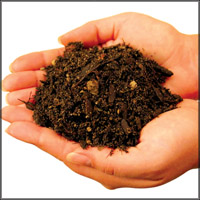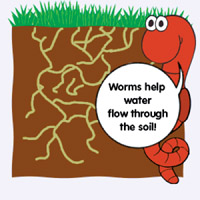 The
soil of the Earth The
soil of the Earth
Whenever
you look around or walk outdoors, or even when you have a fall, you are
dealing with the Earth which we are all standing tall on.
But, did you ever think about how the ground and the rest of the
Earth has been created? In short, have you ever given any thought to
'soil', which is something that we see every now and then and which is
also the material that most of the things around us are made of?
Soil...this is exactly what today's article is about.
What exactly is soil?
This question can be answered in a very simple or very complicated
way. In simple terms, soil is the loose, upper layer of the Earth's
crust. In technical terms, soil is what makes up the
Pedosphere.
The Pedosphere is what lies between the
Lithosphere and the combined
layer of the Hydrosphere,
Atmosphere and
Biosphere.
By now you should know what the Lithosphere is, since it was
mentioned in the last two Geo Facts articles. However, just to refresh your memory, the Lithosphere is the
hard rocky outer layer of the Earth.
articles. However, just to refresh your memory, the Lithosphere is the
hard rocky outer layer of the Earth.
The Hydrosphere, Atmosphere and Biosphere, in simple terms, are the
water, air and life on the surface of the Earth. Soil covers a large
portion of the Earth's land surface. It is an important natural resource
that either directly or indirectly supports most of the planet's life.
If we think about this for a moment, we can see that life on Earth
depends upon soil for food. Plants which are rooted in the soil get the
necessary nutrients from the soil and animals get their nutrients from
plants or from other animals that eat plants. Soil is a mixture of
mineral and organic materials along with air and water.
The contents of soil are never the same in different locations and is
always changing. There are many different kinds and types of soils and
each has certain characteristics including a specific colour and
composition.
Different kinds of soils support the growth of different types of
plants and also determine how well that plant life grows. Soil is formed
slowly, but can be easily destroyed. Therefore, soil conservation is
important for continued support of life.
How is soil formed?
Earth is rocky where its few outer layers are concerned. Therefore,
the scientific theory suggests that soil is formed out of rock after being broken up in to tiny paticles over time.
formed out of rock after being broken up in to tiny paticles over time.
Many conditions affect the formation of soil out of rock, such as
heat and cold, attack by wind, rain, hail and ice. Furthermore, the
massive forces of water which are present when water is expanded into
ice make solid rock shatter into smaller pieces. But, however small
these fragments may be, they still have the same properties as the
parent rock.
So, how would soil change in composition from place to place? So far,
we have delved only into soil being formed out of a parent rock. But, other than that, there are five more factors which affect
soil formation such as time, climate, atmospheric composition,
topography and organisms.
rock. But, other than that, there are five more factors which affect
soil formation such as time, climate, atmospheric composition,
topography and organisms.
The first three factors are obvious. Topography means how different
features in a landscape are arranged. These features might be things
such as the geographical settings and even things such as vegetation,
human-made features and culture.
Organisms which affect soil would be anyone ranging from
micro-organisms such as bacteria to macro-organisms such as all the
animals we come across.
Soil structure
By now you know that soil is made up of rock. When this happens, the
layer of soil resides on top of the rocky layer. This layer of soil can
be broken down further into a few more layers as follows. Note that only
the main layers are shown here and in some situations, intermediate
layers have been defined as well.
* O-Horizon
This is the outermost layer of soil which consists mainly of organic
matter from the vegetation, which are accumulated under conditions of
free aeration (exposed to air). accumulated under conditions of
free aeration (exposed to air).
* A-Horizon
This layer, which is below the O-Horizon, is also known as the plough
zone since it is very rich in organic material, and suits cultivation.
This is made up of mineral matter mixed with some decomposed organic
matter.
* B-Horizon
Residing below the A-Horizon, this layer is made up of clay, iron or
organic matter. Some limestone may also accumulate in this layer.
* C-Horizon
This layer has very little life compared to the upper layers. The
level of micro-organisms is low, and the composition is very close to
the parent material.
* R-Horizon
This is the last layer of soil, which in fact is more of the parent
material itself.
Compiled by Aravinda Dassanayake |
